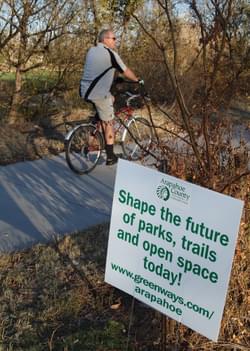




Planning Trails with Wildlife in Mind
Any trail will have at least some impact on wildlife. Therefore, deciding whether the recreational value of a trail outweighs those impacts is a community choice, or in some cases, a legal question.

To conform to legal requirements it is important to check with state and federal wildlife agencies. In order to understand community values related to wildlife and trails, there needs to be a public process associated with a project.
There are many public involvement techniques and abundant sources of information about them. An important first step in understanding how a community values wildlife and trails is recognizing that there are probably many subgroups within a community— many publics. These groups may hold very different values and may need to be invited into the process in different ways.
It is easiest to reach consensus among groups with differing values when there is a common understanding of the issues at hand. That is one of the main purposes of this handbook.
More and more often today, communities are not just discussing their present needs and desires for trails and wildlife, but also ways of leaving choices for future generations.
The concept of sustainability is about meeting the needs of the present without compromising the ability of future generations to meet their own needs. In the case of wildlife and trails, sustainability is about enjoying trails today without precluding the ability of future generations to enjoy wildlife.
A trail that is contributing to the sustainability of an area is meeting people’s fundamental desire to experience nature while not compromising the ecological integrity of the area. This implies careful planning of trails so that they do not seriously degrade biodiversity.
With this kind of forward-looking perspective, it is especially appropriate to restore degraded areas for trails. Improving degraded habitat (i.e., correcting past mistakes) is better than entering undisturbed areas and it acknowledges our obligation to future generations.
K.1 Sweeping statements.
In discussing trails and wildlife, avoid sweeping generalities about wildlife impacts that may not be possible to substantiate or even be true in a specific situation.
K.2 Public values.
Scientific study doesn’t reveal how the public values wildlife. Various kinds of wildlife may be valued quite differently from a public and a scientific perspective.
K.3 Broader perspective.
Frequently, disagreements over trails and wildlife can be resolved by balancing objectives over the broader landscape. It may be harder to balance competing interests of wildlife and trails in the same confined area.
K.4 Public process. Don’t assume everyone in your community values trails or wildlife in the same ways you do. Invite broad public participation on every trail project.
Sustaining Wildlife With Recreation on Public Lands
posted Nov 25, 2023
Humans and wildlife interact in multifaceted ways on public lands with both positive and negative outcomes for each group. When managed well, wildlife-based tourism and other forms of recreation can benefit conservation goals.
Environmental Impacts of Winter Recreation
posted Nov 25, 2023
Regardless of our intentions, many species perceive humans as a threat and respond accordingly. In general, animals respond to threats by first increasing vigilance (time spent looking around versus foraging), and running away if the threat is perceived to be imminent.
posted Nov 24, 2023
Winter recreation is a rapidly growing activity, and advances in technology make it possible for increasing numbers of people to access remote backcountry terrain. Increased winter recreation may lead to more frequent conflict between recreationists, as well as greater potential disturbance to wildlife.
Guidelines for Managing and Restoring Natural Plant Communities along Trails and Waterways
posted Sep 18, 2023
These guidelines are designed to assist resource managers in conducting management activities that enhance the quality of natural plant communities, wildlife habitat, regional landscape integrity and visual quality, particularly as related to planning, development, and maintenance of trails, water trails, and water access sites.
937 views • posted 09/08/2018